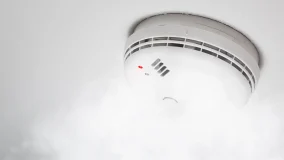Keep Home Safe Carbon Monoxide
6 Tips for Keeping Your Home Safe from Carbon Monoxide
Keeping where you live safe — especially from hazards that cannot be seen with the eye — is essential for a healthy, peaceful, and protected home. Carbon monoxide (CO) is an invisible, odorless gas that can cause sudden illness and death if inhaled in large quantities. According to the Centers for Disease Control and Prevention, more than 420 Americans die from unintentional CO poisoning each year. However, you can prevent these tragedies with the right knowledge and tools. In this article, we’ll explore practical ways to safeguard your home from carbon monoxide issues, and how having a robust homeowners insurance policy will add an extra layer of protection.
1. Install Carbon Monoxide Detectors
The first line of defense against carbon monoxide poisoning is to install CO detectors throughout your home. Place a detector on every floor — especially near bedrooms — to ensure everyone can hear the alarm even when sleeping. When choosing a CO detector, opt for models that feature a battery backup to ensure functionality during power outages, are interconnected so when one sounds, they all do, and have a digital display to monitor the CO levels. Remember to test your detectors monthly and replace the batteries at least twice a year(or consider detectors with a 10-year sealed battery for less maintenance).
2. Regular Maintenance of Household Appliances
Many household appliances, like furnaces and water heaters, can emit carbon monoxide if they’re not functioning properly. To prevent carbon monoxide leaks, have these appliances serviced annually by a professional. This includes cleaning, inspecting, and repairing parts that could lead to CO emissions. It’s a small investment that not only prolongs the life of your appliances but also ensures the safety of your home’s air quality.
3. Proper Ventilation
Preventing CO leaks into your home starts with giving fumes a quick way to exit the building, while allowing fresh air to enter. When fuel-burning appliances are installed, ensure venting is adequate and doesn’t become blocked. Regularly inspect the vents for blockages, such as bird nests or debris, and keep the area around your appliances clear of any storage or clutter that could restrict airflow.
4. Safe Use of Generators and Grills
Never use generators, grills or other gasoline-powered equipment indoors or in enclosed or partially enclosed spaces such as garages — even with the doors open. These devices produce CO and can quickly reach dangerous levels if not used in well-ventilated areas. Always operate them outside, away from windows, doors, and vents to prevent fumes from entering the home.
5. Educate All Household Members
Awareness is a powerful tool. Make sure everyone in your household understands the risks of carbon monoxide poisoning and the symptoms, which include headaches, dizziness, weakness, upset stomach, vomiting, chest pain, and confusion. These symptoms are often described as “flu-like” and if not treated quickly, could lead to loss of consciousness and death. Educate your family on the sound of the CO detector alarm and establish a safety plan.
6. Do Not Ignore CO Detector Alarms
If a CO detector alarm goes off, treat it with the utmost urgency. Evacuate everyone to fresh air immediately and call emergency services. Do not assume it is a false alarm or try to find the source of CO. The right response to an alarm may mean the difference between life and death.
Protection Against Invisible Threats
Homeowners insurance is not just a safety net for the unexpected; it’s a proactive partner in the protection of your home. If CO leaks into your home, it could have a negative effect on your emotional and financial health. This is where a robust homeowners insurance policy shines. It could help cover the costs of repairs to any damaged appliances or systems that might have caused the CO leak.
Beyond the immediate repairs, if the CO incident leads to the discovery of larger systemic issues within your home — such as outdated piping, a faulty heating system, or breakdowns in equipment caused by changing weather — home insurance may help pay for necessary upgrades to prevent future hazards.
Moreover, if a CO leak makes your home temporarily uninhabitable, many policies offer coverage for additional living expenses, ensuring that you and your family have a safe place to stay while repairs are made. In the shadow of such unseen dangers as carbon monoxide, homeowners insurance provides a beacon of financial relief and reassurance that allows you to focus on the well-being of your family rather than the burden of unexpected expenses.
Secure Your Peace of Mind with Acceptance Insurance
When it comes to your home and family, leaving things to chance isn’t an option. Acceptance Insurance is dedicated to offering homeowners insurance that stands as your first line of defense against unforeseen and hidden dangers such as carbon monoxide. With our comprehensive coverage, not only will you have the financial support for repairs and unforeseen living expenses, but also the assurance that comes with knowing you’re protected. Don’t wait for a sign; the time to safeguard your home is now.
Contact an agent today so we can help you choose a homeowners insurance policy that keeps you one step ahead of the risks.
Common Questions About Carbon Monoxide Prevention Tips
What is carbon monoxide and why is it dangerous?
Carbon monoxide (CO) is a colorless, odorless gas that is produced when fuel is burned in cars, trucks, small engines, stoves, lanterns, grills, fireplaces, gas ranges, or furnaces. CO can accumulate indoors and poison people and animals who breathe it. The danger lies in its invisibility and its ability to cause sudden illness and death without warning.
How do carbon monoxide detectors work?
Carbon monoxide detectors measure the amount of CO over time and sound an alarm if the gas levels become dangerous to humans. The alarm gives people a chance to safely leave the area and take action before dangerous levels of CO can cause harm.
Where should I place carbon monoxide detectors in my home?
You should install CO detectors on every level of your home, including the basement, and near each sleeping area. It’s also a good practice to place a detector near any major gas-burning appliances like a furnace or water heater.
How often should I test my CO detectors and replace them?
Test your CO detectors at least once a month by pressing the test button and replace batteries every six months if they’re not hardwired or powered by a 10-year sealed battery. Replace the entire CO detector unit every 5 – 7 years or according to the manufacturer’s guidelines.
DISCLAIMER:
Material in these articles is for general information or entertainment purposes only. Acceptance Insurance does not endorse and is not affiliated with any of the companies or apps listed in this article. Acceptance Insurance is not responsible or liable for the availability of links to websites or resources, or for any content, advertising, products, services or other materials on or available through these websites or resources. Any references to third party rates or products are subject to change without notice. Trademarks are property of their respective owners. Information and coverage descriptions are general in nature. Actual coverage depends on the policy. Nothing in this article alters the terms or conditions of any of our renters policies. Homeowners policies are underwritten by third-party insurers that are not affiliated with Acceptance and are solely responsible for claims. Supplementary coverage options may be added to an insurance policy for an additional cost where applicable. See your agent for more information. Product and features are subject to underwriting criteria. Not all products, discounts, or payment plans are available in all states or distribution channels. All products described herein are subject to terms and conditions. CA License #0K20173.



